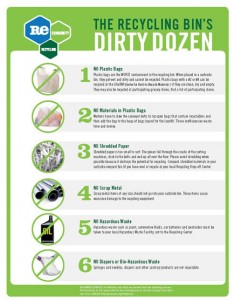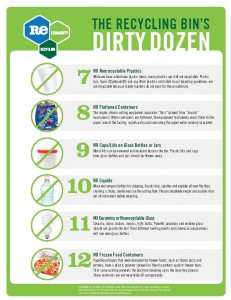So you want to recycle, but aren’t always sure what is acceptable for recycling in Delaware. Recently Hetty Franke and Marianne Cinaglia toured the ReCommunity single stream recycling plant recently with the Recycling Public Advisory Council (RPAC). While there they received some important tips about recycling practices.
1. There were plastic bags floating through the air and wrapped around axles throughout the plant. Do not, do not, do not put plastic bags in your recycle containers! Plastic bags belong in the store collection containers.
2. Also flying through the air and covering the floor and ground outside was”confetti” made of shredded paper. This is another no no for recycling.
3. Tops should be removed from containers before the containers are added to your recyclable materials. Containers with trapped liquid weigh more than empty ones and are missorted in the single stream process. Caps are usually made of different plastics than the container. Capped bottles make the packaging process more difficult.
The ReCommunity plant is presently running on one shift a day. In July the plant will add another shift. This addition places the plant about two years ahead of the initially planned increase in recycling capacity. On the ReCommunity website you can take a trip through a virtual single stream plant. Another great resource is: The Recycling Bin’s Dirty Dozen. This contains the complete no no list and may be what you want to post in your newsletters.
NO-NO LIST
- NO Plastic Bags
- NO Material in Plastic Bags
- NO Shredded Paper
- NO Scrap Metal
- NO Hazardous Waste
- NO Diapers or Bio-Hazardous Waste
- NO Non-Recyclable Plastics
- NO Flattened Containers i.e soda cans
- NO Caps/Lids on Glass Bottles or Jars
- NO Liquid
- NP Ceramics or Non-Recyclables
- NO Frozen Food Containers
For more information on recycling, check out the DNREC site. Also check out this recycling guide for additional tips to best practices.


